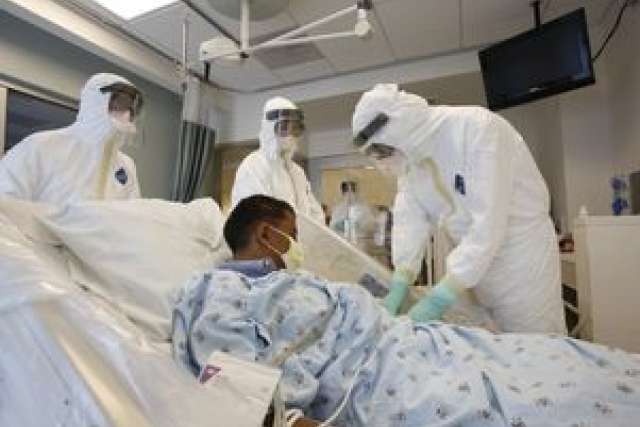“This was an important exercise and allowed our health care team the opportunity to practice and receive valuable feedback from the Department of Public Health,” said Dr. Zachary Rubin, associate clinical professor of infectious diseases and medical director of clinical epidemiology and infection prevention at the Ronald Reagan UCLA Medical Center. “Preparing for patients stricken with Ebola has involved a significant amount of time and thought. We are trained and believe we are prepared to care for such patients, and that includes doing everything we can to ensure the health and safety of all of our patients, faculty and staff, and the community.”
The exercise was designed to test the hospital’s plan and processes for caring for people with Ebola. As part of the exercise, the hospital prepared as if it were receiving one person who was suspected to have the disease. Emergency department nursing staff led the patient through an outside entrance into an isolation room in the emergency department. The medical team then admitted the patient directly to a specially designated and prepared room in the hospital.
Protocols for infectious diseases, safety, treatment and bio-containment were in place and were successfully deployed.
“UCLA is working hard to ensure we are fully prepared and that we keep the safety of our patients and staff a top priority as we extensively plan for a possible Ebola patient at UCLA,” said Dr. Robert Cherry, UCLA Health System’s chief medical and quality officer. “We have a designated Ebola response team composed of experts from infection prevention, emergency preparedness, nursing, safety, the clinical laboratory, and other areas who are meeting regularly to update our comprehensive plan.”
The hospital’s multipronged approach includes protocols for identifying a patient brought to the emergency department, disposing of waste, designating equipment such as ventilators and X-ray machines for Ebola patient use only, setting up a mobile laboratory, using specialized personal protective equipment and training staff.
“During the drill, our clinicians put on protective equipment, transferred the patient to the ICU, performed blood tests and waste removal, and safely removed worn protective equipment,” said Dr. Daniel Uslan, associate clinical professor of infectious diseases and public health, and associate medical director of clinical epidemiology and infection prevention at the Ronald Reagan UCLA Medical Center.
UCLA has put together personal protective equipment kits that exceed Centers for Disease Control and Prevention standards and are based on practices developed at Emory Medical Center in Atlanta, where four people with Ebola have been treated to date.
Numerous occupational safeguards would be taken as part of UCLA Health System’s response plan. UCLA hospital workers would wear personal protective equipment whenever they come into contact with a patient who is suspected to have been infected with the Ebola virus, and they would put on and take off the gear under the supervision of a designated safety officer. In addition, healthcare workers would not be permitted to enter or exit an Ebola treatment room without a safety officer’s approval. These precautions are consistent with standards set by the CDC and by California’s Division of Occupational Safety and Health (Cal/OSHA), and are the same universal precautions health care workers use whenever they are caring for any patient with a potentially infectious disease.
UCLA Health System also complies with all state and local public health regulations, as well as guidelines provided by the CDC and Cal/OSHA regarding other important infection control practices, such as isolating patients, and using specific cleaning protocols and products.
“We deal with patients with other infections such as tuberculosis and multi-drug–resistant bacteria on a daily basis,” Rubin said. “Our teams are well versed in caring for patients with other communicable diseases.”
UCLA Health System also has adjusted its medical record system to place a red flag on patients’ electronic charts if they have recently traveled to high-risk areas. For people who are suspected of having Ebola, blood analysis will be conducted in a mobile in-room lab and not the medical center’s regular laboratory, ensuring that no blood samples will be removed from the patient’s room.
“Our role as the Los Angeles County Department of Public Health is to be the bridge that connects us as quickly as possible with the lessons learned in other communities and puts those into practice here,” said Dr. Jeffrey Gunzenhauser, interim health officer for Los Angeles County. “Our goal is to keep all health care workers, especially those on the front lines of patient care, safe. We urge all hospitals in Los Angeles County to develop exercises based on those lessons and adapted to their own facility’s unique needs to help ensure staff are comfortable and skilled in the use of those safety procedures.”
William Dunne, administrative director of UCLA Health System’s emergency preparedness, safety and security services, noted that every hospital has plans and appropriate supplies and equipment in place to care for patients with infectious diseases. “California hospitals prepare for all types of emergencies every day in order to provide necessary care for their patients and the communities they serve,” he said.



